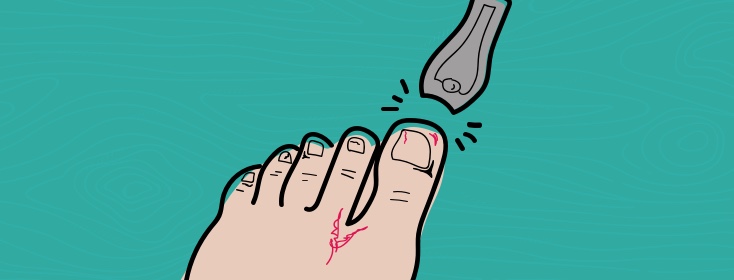Psoriasis and Ingrown Toenails
There was a period of time, when my skin was at its worst, in which I had to visit urgent care three times in as many months for infected ingrown toenails.
How does psoriasis affect the nails?
Psoriasis affects the nails, and ingrown toenails can be a result of that. I know this is a little bit of a gross topic (especially if you are like me and hate feet.) However, I would not wish ingrown toenails on my worst enemy, so it's important to me that everyone knows the best way to avoid them.
Learning more about ingrown nails
In case you are reading this and have never experienced an ingrown toenail (you lucky duck!), I will start out by explaining what it is. First off—if you feel like impressing your friends, the scientific name for this horrible condition is onychocryptosis.
Basically, it is when the corner of the toenail grows into the skin surrounding the nail. The big toe is usually the culprit. When you have psoriasis, your nails are often already compromised. It is common to have brittle, cracked and pitted toenails.
Avoiding ingrown nails
There are many other factors that can contribute to ingrown toenails, including genetics, nail shape, and having enlarged skin around the nail. Here are a few tips on how to avoid ingrown nails.
- Cut them JUST right: It is important to keep your nails cut short, but not too short. You also should be careful as you wield your clippers to cut the nail straight across. Don’t try to get fancy with round or square round shapes, as this may make it worse.
- Avoid picking: It can be tempting to pick at peeling toenails or rough edges, but that runs the risk of making the nail edge uneven and a prime environment for growing inward towards your skin.
- Keep the skin soft: Moisturizing is commonplace when you have psoriasis, but don’t forget your feet! Keeping your tootsies soft and hydrated will discourage ingrown toenails.
- Wear well-fitting shoes: Shoes that are too tight will push the nails down into your skin, which is what we want to avoid. Let those toes be free by wearing open-toed shoes or buying a shoe that is half a size larger than normal. I definitely avoid those glove shoes (which always creeped me out anyways!)
- Be particular about your pedi:Pedicures are great for foot and nail health, but be selective on the salon you choose. Always read reviews and choose reputation over price.
The many different treatment options
Regardless of how well you take care of your toes, sometimes ingrown toenails happen. They are irritable and painful, but thankfully they are easily treated. Here are some common things to do if it happens to you.
- Soak in Epsom salt: Most of us have Epsom salt on hand by the boatload to help soothe our skin. The first course of action I always take with an ingrown toenail is to soak my feet for about 30 minutes in a warm Epsom salt bath. This sounds fancy, but really it is just me sitting in my living room with my feet inside a large casserole dish.
- Change the course: You can encourage your nail to grow away from the skin by packing a little bit of cotton under the nail to give it a gentle push. Some experts recommend soaking the cotton in alcohol first to prevent bacteria getting under the nail.
- Watch for infection: Feet can be dirty, so always be cautious to monitor for infection.You can try and reduce the risk by applying antibacterial ointment to the site. If it becomes hot, red, inflamed, or you see a red line running from the area, call your doctor. This is what landed me in urgent care. Luckily, it is easily taken care of.

Join the conversation